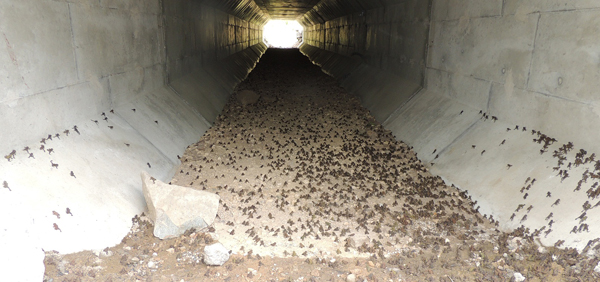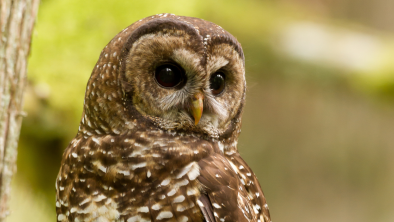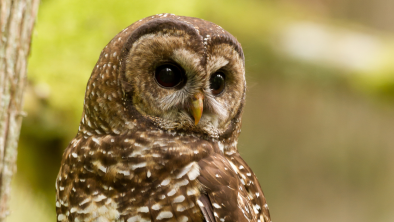Nakusp Residents Hopping Mad over Logging in Toad Country
The Tyee

Forestry plans pit village citizens who love their amphibians against a company they own.
Kiss the right frog, the fairy-tale has it, and you'll get a prince. There's no such reward promised for kissing a toad, yet both sides in an escalating dispute in southeastern B.C. claim to be fighting for the unlovely Western toad -- a lumpy, mottled grey and brown amphibian of ''special concern'' on Canada's registry for species at risk.
Western toads are among Canada's largest, growing to more than 10 centimetres in length. They mate at the shallow edges of freshwater lakes, where thousands of offspring develop as swimming tadpoles (if they escape being eaten) before clambering ashore to begin a mainly terrestrial juvenile and adult existence.
Along with almost all the country's other amphibians, Western toads are losing their natural homes to the humans who share their taste for waterfront living. Their status as a ''concern'' on the species at risk registry could easily tip into ''threatened'' or ''endangered'' (almost gone) status.
Which makes the conflict at Summit Lake a matter of high stakes for the toad.
Summit Lake, about 130 kilometres east of Kelowna and just south of the hamlet of Nakusp, is one of the places where Western toads live and breed. Each summer, a rippling brown wave of hundreds of thousands of tiny ''toadlets'' emerges to climb and hop up the hill to forested land and adult life.
It's already a hazardous trip: The baby toads must cross busy Highway 6 to reach the comparative safety of woodland on the other side. Thousands die under the tires of passing vehicles.
The B.C. Ministry of Transportation and Infrastructure spent $200,000 on a toad tunnel beneath the highway to protect what it called one of ''the great wildlife migrations in the world.'' But many toadlets don't find the tunnel, so for the past five years, enthusiasts have assembled in an annual ''toad festival'' to carry as many as they can across the asphalt.
But now the toads that make it across the highway face a new threat: Logging in the forest where they normally shelter for as long as four or five years before returning to Summit Lake to mate. 
Logging in 'core habitat'
Timber rights to the forest are held by the village of Nakusp. The small municipality -- 1,574 people in 2011 -- holds the logging rights to 10,000 hectares scattered around the area through a village-owned company called Nakusp and Area Community Forest (2013) Inc., or NACFOR.
Nakusp Mayor Karen Hamling referred a request for an interview to NACFOR.*
The company, which has no employees, contracts with a private business, True North Forestry Consulting Ltd., to log its holdings.
True North's owner Hugh Watt told the Canadian Press last month that its operations contribute $1.2 million to the local economy. In 2012, NACFOR paid the village a dividend of more than $50,000.
It was True North's decision to log the contested slopes. ''That area has been designated as a timber supply area by the province,'' its project manager for the NACFOR contract, Frances Swan, told The Tyee by phone. ''We considered everything and decided that this was an area that we could develop for forest resources.''
Last month, the B.C. government approved True North's plan to ''develop'' the toad's habitat, and the company began road clearing in preparation for logging later this spring.
This has outraged some of Nakusp's citizens. ''What Nakusp residents are asking for is responsible logging,'' says Debbie Pitaoulis. ''It isn't responsible to log in the core habitat of the Western toad.''
Gwen Barlee, policy director with the non-profit Wilderness Committee, noted in a release that the government's own management plan for the Western toad calls the Summit Lake region one of its key breeding areas in the province.
''Western toad populations have undergone dramatic declines in the southern part of their range,'' she wrote. The Wilderness Committee is pushing for the expansion of an existing provincial park on Summit Lake to protect additional toad habitat.
A position paper about the toads written on NACFOR letterhead, which Swan provided, doesn't dispute the importance of the area to the Western toad though it does point out that the animal is ''widespread throughout their natural range in North America.''
NACFOR's statement says True North's ''careful operations'' will result in ''a light footprint over a relatively small area.''
''Wildlife tree patches'' and ''unique toad habitat features… identified by experts'' will be retained, it says.
''Ground breaking research… is being used to create best management practices for forestry operations in Western toad habitat which can be used to guide operations in other areas,'' the statement says. ''If we do nothing, we will learn nothing.''
The village company also argues the toads have survived previous onslaughts on their habitat. ''The Summit Lake area was extensively logged prior to 1925. There was a catastrophic wildfire in 1925. The lake has been treated twice to get rid of coarse fish in preparation for stocking with game fish,'' NACFOR observes. ''There is a long history of disturbances there.''
And if local residents are concerned about toad habitat, the company challenges, they ought to ask themselves what happens on their own privately held foreshore and riparian areas.
''For example out of a two-acre lot, what proportion is typically cleared and occupied by structures or other developments?'' NACFOR asks, “What are the individual and cumulative impacts?''
'Like cattle going into the chute'
The village-owned company questions the motives of those like Pitaoulis and Barlee who oppose its operations. ''Special interest groups,'' it claims, ''are attempting to galvanize people around an anti-logging/anti-development agenda in an effort to fulfill their mandate to create parklands'' which ''will not solve any of the issues identified.''
''Because that area is part of the Nakusp Community Forest,'' Swan added, ''NACFOR does not support the expansion of the [existing] park.''
But NACFOR's claims of ''best practices'' are in doubt. ''Claims to log and maintain core toad terrestrial habitat are on very shaky ground,'' argues local biologist and Valhalla Wilderness Society member Wayne McCrory.
''For one thing, no one knows exactly where the one million or more toadlets that just migrated [last summer] into the areas to be logged are actually spending the winter hibernating.''
Pitaoulis says it's ''tragic'' that the province's largely successful toad tunnel will now force the toadlets into an area that is going to be logged ''like cattle going into the chute.''
Meanwhile, the one option NACFOR does not appear to have considered, according to its statement, is foregoing cutting. Sadly, many of the companies' counter-allegations against private property owners are far from fanciful.
In the finger-pointing, the toads are the likeliest losers.
Top: Adult western toad (Isabelle Groc)
Below: Summit Lake toad tunnel (BC Ministry of Transport & Infrastructure)


